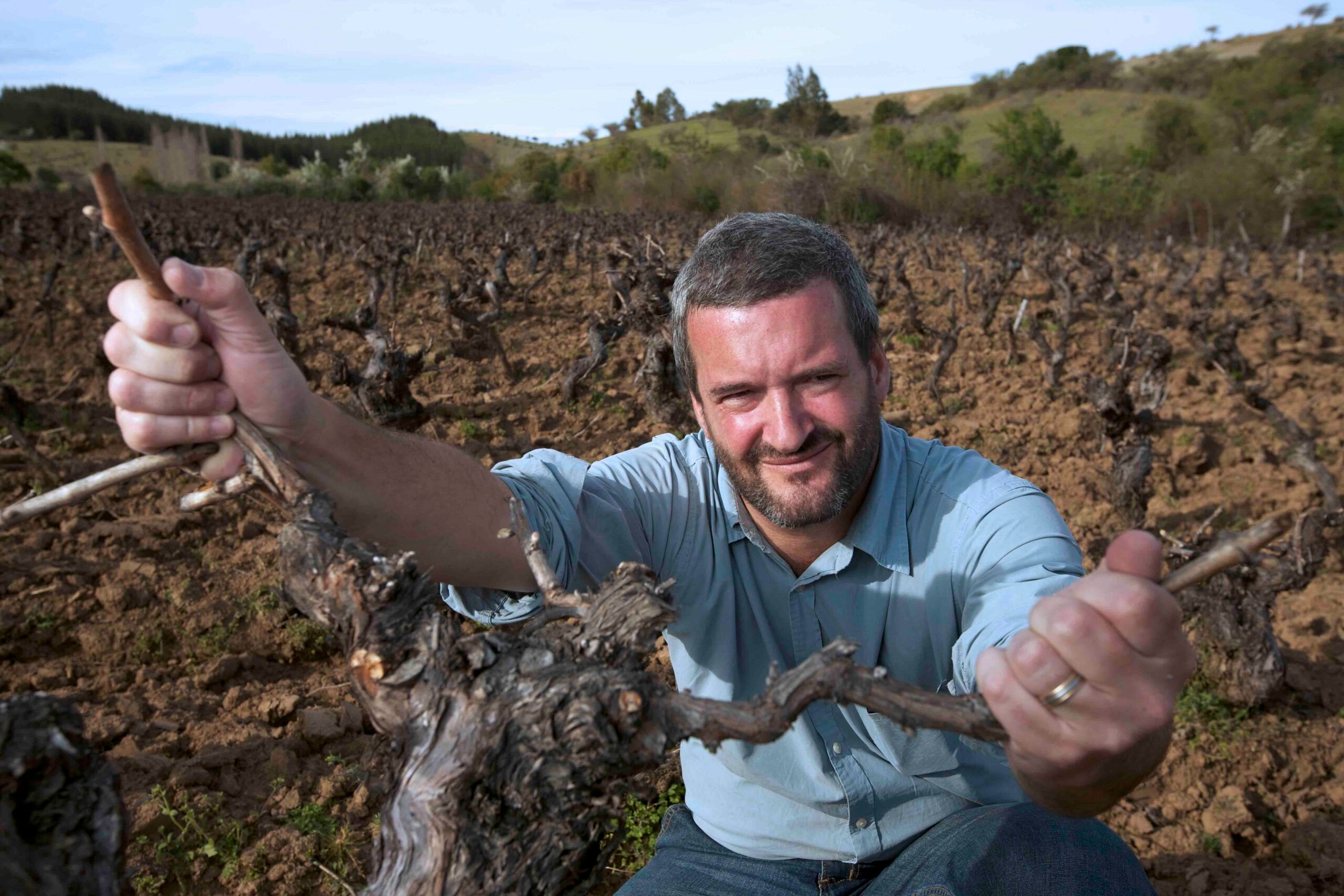Garage Wine Company’ Derek Mossman Knapp looks back on a year like no other and how lockdowns and zoom tastings have given smaller wine producers with a story to tell a whole new voice and way to reach a much bigger audience.
How are things been for you so far in 2021 and coping with the fallout of Covid?
Garage has always sold more cases on-premise than retail the independent sector so pivot has been the operative word. Mostly, we have helped our distributors and restaurant customers to pivot supporting them with zoom tastings and events.
People had time at home and itchy fingers for Door Dash, Uber Easts, Pedidos Ya so we put extra effort into sharing what we are up to in the hope curious consumers would spend some time and then click to buy a bottle or a case. It turns out that when people have more time to kick and click about they make more informed choices. We have had two good years and much more contact with distributors and consumer – which should bode well for future.
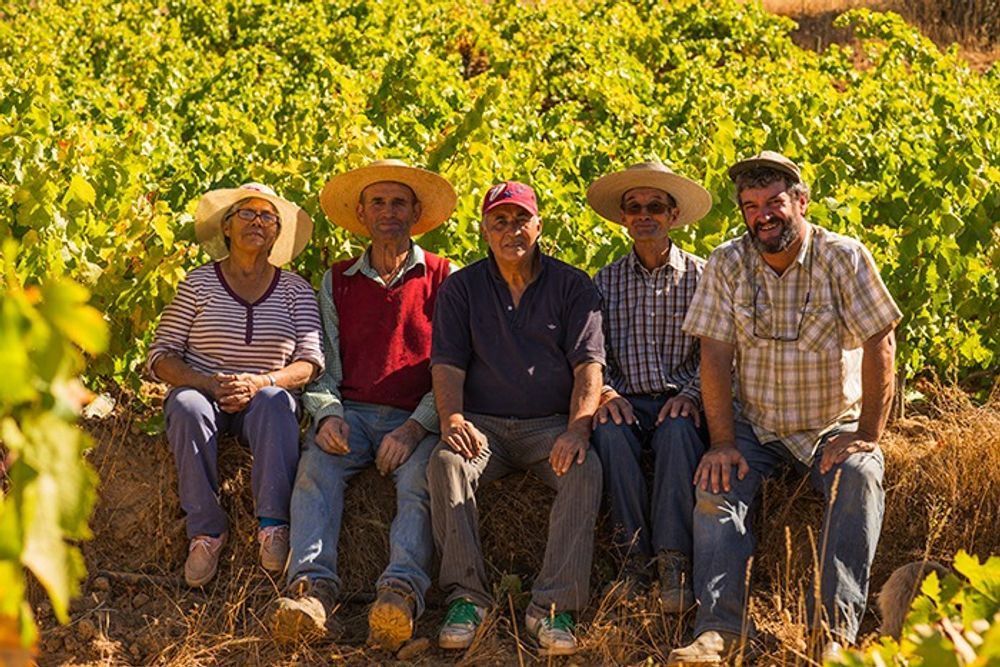
Derek Mossman with some of his local wine team who he says are the real heart and soul of the vineyard and the wines that Garage Wine Company produces. Picture Matt Wilson Www.MattWilson.cl
Just about every market study I know is modeled around large brands, but it is clear to me better informed consumers have bought much more outside of the mainstream than ever before and it is easy to see why: most content online is trimmed for the attention span of the consumer in a hurry, so it was just too slick and polished for the times. It was made to be too far removed from the winemaking and the farming with well-produced pictures taken too long ago and out of season. I think in times of Covid all that lost out next to a dose of more personal grittiness and the whites of workers eyes (seeing as their mouths were covered with masks).
Turns out that when people have time, they do their online due diligence and find things more consequential. I guess the question is what happens when we get back to normal? I cannot help but think the exposure will bode well for the consequential to have a larger role in a new usual.
Garage is in no way unique. Take Pedro Parra’s book Terroir Footprints that came out during Covid. I think the reason he did so well with it is not the technical aspects of the Cuarcic Granitic of Chile’s Coastal Range, but rather the personal and relatable perhaps even quixotic tale of he and his family learning the ropes in the wine consultancy business. It is him, his personality and humanness that makes it work, and perhaps finally understand the bedrock analysis more profoundly.
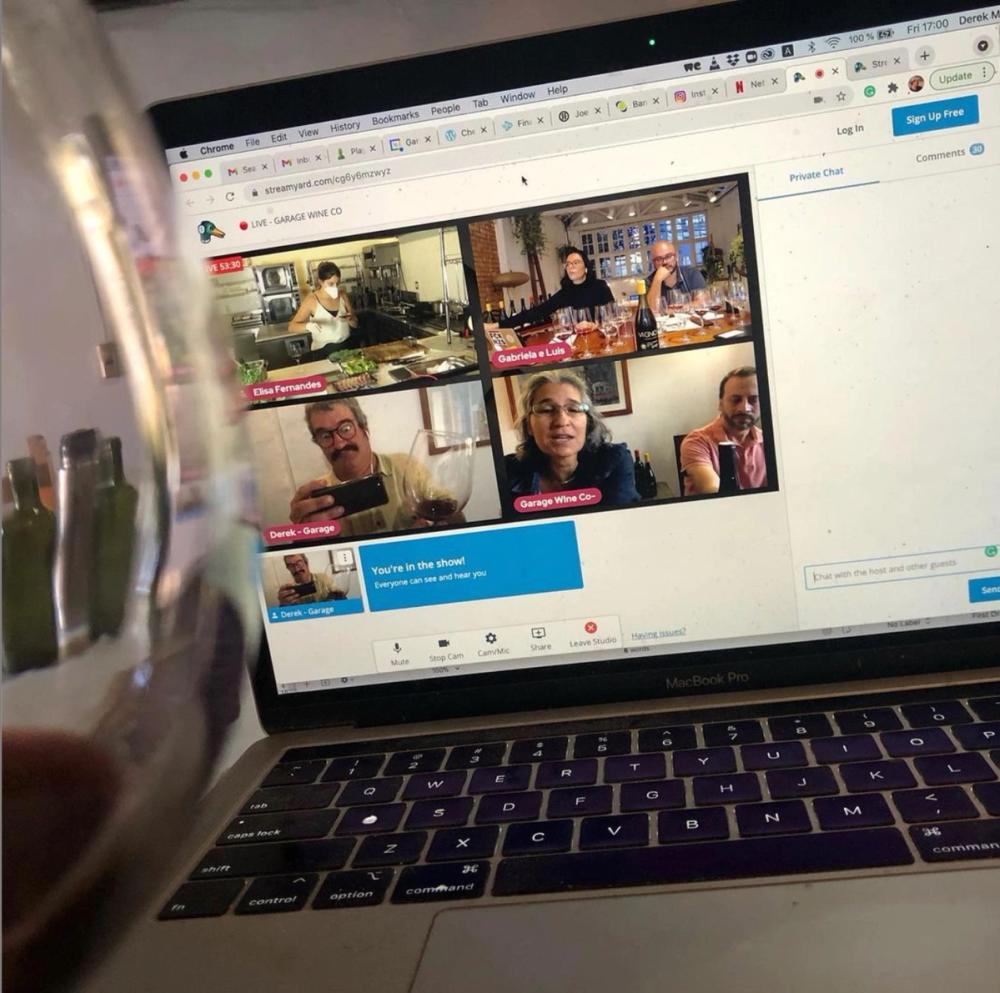
Derek Mossman believes the wide use and acceptance of Zoom tastings has been a big advantage and opportunity for producers like Garage Wine Company that have an offbeat story to tell
Do you remember all the Instagram interviews? Fernando Mora MW? It was fantastic to get closer to people normally more removed from the conversation. My favourite was when Paul Greco of Terroir New York interviewed Eric Asimov. It was as if Asimov came down from the mountain and was a mortal with us – – a game changer.
What are the main changes have you had to make to the business and your export strategy?
In the times of social distancing the key was: get closer. In US we fired our central importer who was distancing us from our customers. We began to work the next day with people that would help us get closer. Today we work six to seven states directly and all the others with a more agile importer comprised entirely of women – women who get it. My partner [in life and Garage] Pilar is our MD so I am the only man in the meetings – do I need to say we have never done better in the US?
Another change has been incorporating a proper QR code on the back label of each new release. QR’s are now everyday and native on every phone. In an instant, the consumer has access and info about the wine they have in front of them: an IGTV video clip, pictures from the last six to seven vintages (of that particular vineyard). They can also read techsheets of the last two to three releases, and how to find another bottle depending upon where in the world you are. It cost $150 to do and the rest has all been about teaching ourselves what to do.
(You can see the QR code for yourself below with a link to the Revival video and other information)

I think it works because it assumes you have a bottle in your hand and it tries to bring you closer and give you better reason to take the bottle home. Let’s face it, where Garage sits on the shelf it is still just easier to take home a bottle of Burgundy. No one questions the choice of Burgundy. But if, at a click, you get a clearer gist, an anecdote, a story about where this bottle comes from, well, then you are armed to put us in your shopping cart or carry us under your arm with purpose. How is that for closer?Listo! And Alt-Chile grows one click at a time.
I am a winemaker, but I am also an entrepreneur. I didn’t inherit a cellar we have built it, Pilar and Alvaro and myself, brick by brick over 20 years now.
You have taken steps to help your workers and also the local community by starting the Revival programme – how does it work?
The success of Chilean wine has led suppliers to plant fundos of 500+ hectares and some times over 1,000+ hectares and these have created a van culture where people travel 45 minutes or one hour to work. It’s good work and it brought more freedom to be able to work where you want, but with Covid it meant mixing with people from other towns picked up on route. We saw this danger and built a project that got people working closer to home. We saw vines in workers backyards that were slowly drying up out of neglect.
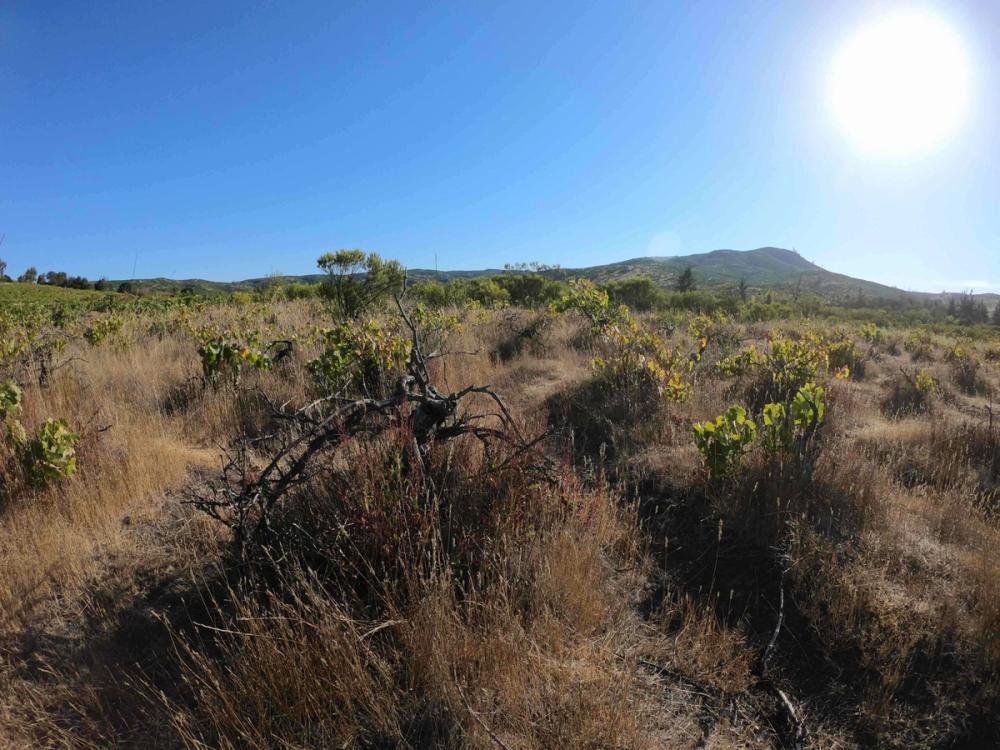
The Garage Wine Co Revival programme involved encouraging workers to work on vineyards closer to home, helping to revive neglected vineyards and avoid having to travel long distances that were not covid secure during the height of the pandemic. Here’s the ‘before’ picture taken prior to any work being carried out.
They looked like hell, but sometimes even when a vine above ground looks like hell the root structures are in better shape. We knew these vineyards weren’t neglected because of quality issues, but rather because they were too small to fill a truck, or they were too far from a paved road. Their rows are so tight (that is how they planted 100 yrs ago) that you cannot get a tractor in to spray nor a machine in to pick. We created a project to revive them – hence the name.
We were then fortunate to have two of our importers help fund the project by paying for the wines in advance – en primeur-style. Some of you will remember our Ploughman Cariñena project after the earthquake in 2010 when we won the Geoffrey Roberts Award. Wines paid for en primeur gave us the funds to work in the neighbourhood. We knew the model worked. Our Swedish importer, Handpicked, got us started and then a few months later – about the time when we realised we had bitten off more than we could chew, I had a chance meeting with Robin Copestick of Freixenet Copestickin Santiago. He loved our Single Ferment País, the wine and the history. We got talking and three months later we have a properly funded Revival programme and a new UK importer: Freixenet Copestick.
But there is also a double meaning to the word ‘Revival’ .
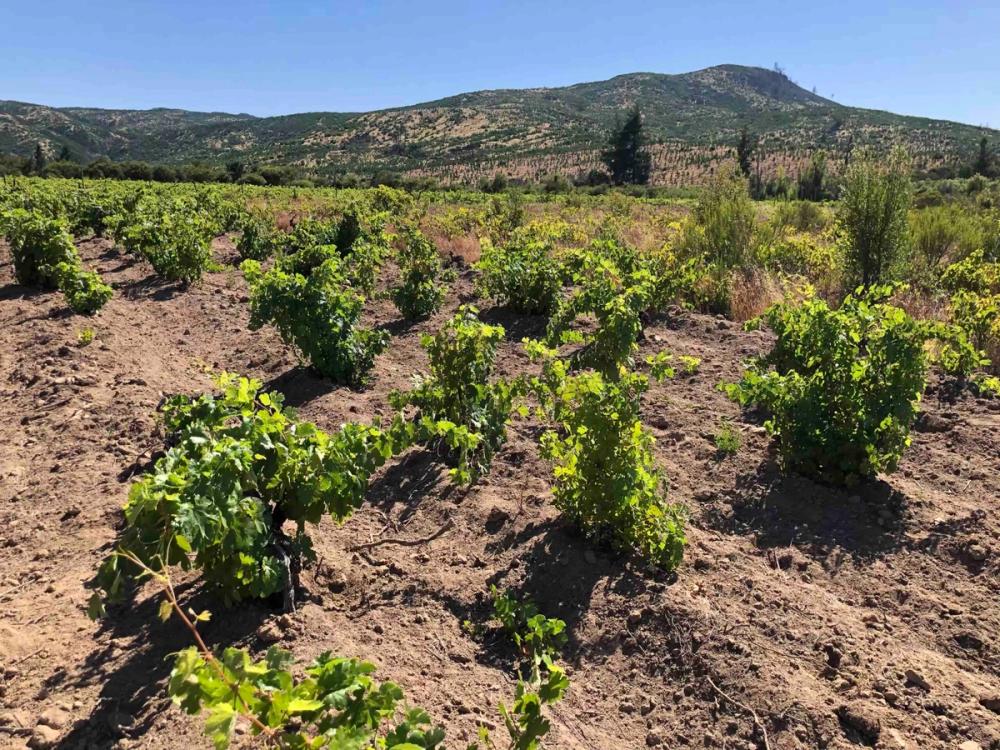
Here is a picture of the same vineyard as above after it has gone through Garage’s Revival programme
Yes. Revival is a village wine made of País sourced from various old vine vineyards that simply put do not fit into the modern wine business model. Think history and flavour trumped efficiency. País is the original grape that was taken to the Americas from the Canary Islands with the Spanish conquest. País has been dry-farmed in Chile since 1548. There is even a tax document to prove it. Just think about what was going on in the world in 1548. Henry 8th died the previous year, Mary was Queen of Scotland, Elizabeth [the first one] would not take the thrown for a decade. There wasn’t any claret in London yet because Cabernet Sauvignon would not be invented until 1763.
Now, fast forward and just imagine such old vineyards passed down over all this time – probably 15-20 generations – imagine them suffering from neglect and some even being plucked out. And not because they stopped making wonderful wine, but because the vineyards were disconnected with the new wine trade that was all about efficiency and price.
The mainstream viticulturists would have the small farmers spray instead of cultivate and scale instead of focus, above all “reduce the cost of labour”, but the labour – we have learned over 20 making Garage is what captures the flavour.
Suffice it to say there is a whole lot of history to be bottled and it will be shipped to the UK for nextfFall. Right now, it is in a fudre rounding out and finding its legs.
How have you managed to implement the programme and get vineyards and the community involved?
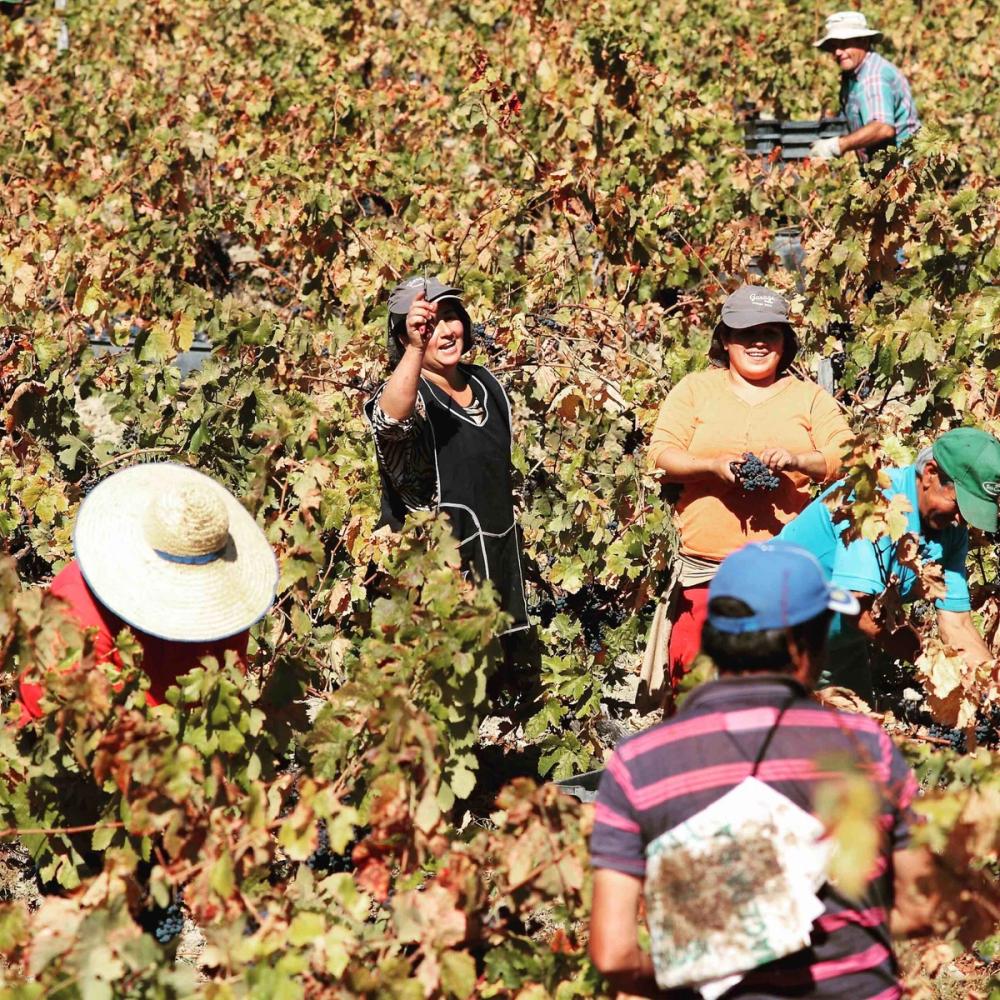
The local community has taken to the Revival project as much as it has working with Derek Mossman
We have worked with a growing team within the community over many years now. Most are certain I (we) are nuts, but they know that nuts has worked before. Cynical neighbours said we should replant because it would be cheaper. They completely miss the point. Old vines are like icebergs. The part we see, the gnarly bits above the surface that fascinate photographers are only a small part of the real vine.The roots, and their capacity to drink deep, are the real maravilloso of old vines. The above ground bits are more frail as they live in an atmosphere with oxygen and seasonal swings in temp and conditions, but underground vines are much more resilient than most people realise.
It is incredible to see before and after. In some of the worst scenarios where fire burned through in 2017 on top of neglect in one site at least about 60% of the plants are on the road to recovery. Plants are treated one by one and many need time to recover before they will provide fruit for the programme, but Garage is 20 years old this year and we have been working any of these old vines for 12-13 yrs of that so we are not in a hurry. We just take vine by vine
What sort of response have you had to it?
When we began the farming works people thought we were nuts. When we persisted they came to us with ideas for other locations where we could continue, so we started a ledger. Strictly speaking it was en primeur so it’s all sold, but I look forward to getting behind it in the markets. País has never been a thing in the UK like it is in America. All we are saying is give País a chance.
Do you see there being long term parts of the programme you can keep going with in the long term?

This will not be a one off. The vineyards revived will find their way into our portfolio. It is a good start born of special times, but there is a great deal of work ahead adopting a more profoundly regenerative agriculture. Perhaps the most important element is the generational challenge. Young people are leaving for the city. They have seen how their parents have suffered. The vines are neglected because farming on a small scale has been neglected. Garage needs to convince young people to stay on the land.
How was the 2021 vintage in terms of quality and quantity?
2021 was mixed. We had hail, yes hail, in our Las Higueras Cab Franc vineyard in Maule and this led to a harvest of 35% less than 2020. That said the two pickings we made this are terrific. A fresher summer led to great quality fruit in the Maule and Itata.
We also have a business growing high-calibre fruit for large cellars, who for obvious reasons find it difficult to farm “small” as it were.Over the years we have became specialists in managing small farms – we have never had the budget to manage a large one – and on two of these farms we sell fruit on to others.
It is on these small farms where farming, as we know it, is undergoing a re-thinking and regenerative agriculture is beginning to emerge. The idea of soils less compacted, with cover crops allowing for greater life and microbes in the soil being beneficial for the balance and quality of the fruit is beginning to take hold. We have some terrific allies in the vignerons from yesteryear still working with horses and we are combining this with ideas and the lens of modern science of our third partner Alvaro Peña PhD in viticulture toward growing more consequential fruit.
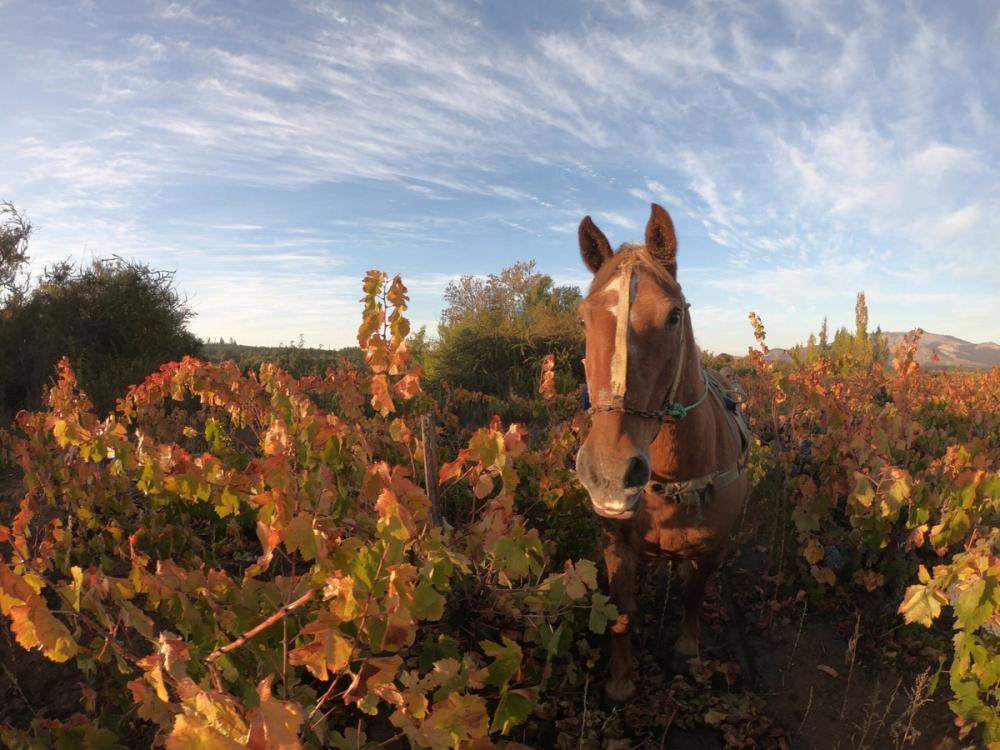
Horses are a key part of the vineyard in Maule and Itate where Garage Wine Co makes its wines
What are the likely impact of prices from Chile do you think?
The trials and tribulations of mainstream and commodity fruit and wines is outside my view. We march to a different drum. The two businesses might seem to be related, but I assure you Alt-Chile, as I like to call it, has different rules. Alt-Chile is less price sensitive and is healthy and growing. The Garage grows to be sure, but we are not scaling up. Our business today is still 80% parcel wines and less than 20% single ferments our entry level. The challenges I am focused on to help us grow have to do with the idea of business as a force for good.
The mainstream’s disconnect with the old vines and small farmers in Chile is a gap I think we can help narrow. I participated in Sarah Abbot MW’s Old Vine Conference the other week and I am confident there are others who agree with me, wherever they farm.
What are the immediate plans with Freixenet Copestick?
As soon as the wine arrives in the UK, which is imminent, Jascots will sell to the London on-trade. I hear they already have significant interest from a number of high profile customers. Jascots has become famous for championing smaller suppliers with a sustainable angle so our wines suit their portfolio. Freixenet Copestick will also sell to the UK independents and national wine specialists.
Do you see more opportunities to develop into different channels of the market – like online with Slurp
Yes absolutely, it is time to offer the wines direct to consumer on Slurp – also part of Freixenet Copestick. We have sold some cases through indies over the years, but this has never been our strong suit so I really look forward to working this side of the market. We have been zooming, and the Slurp team are really excited to start marketing our wines and have a whole raft of ideas to make our wines unique to the Slurp customers.
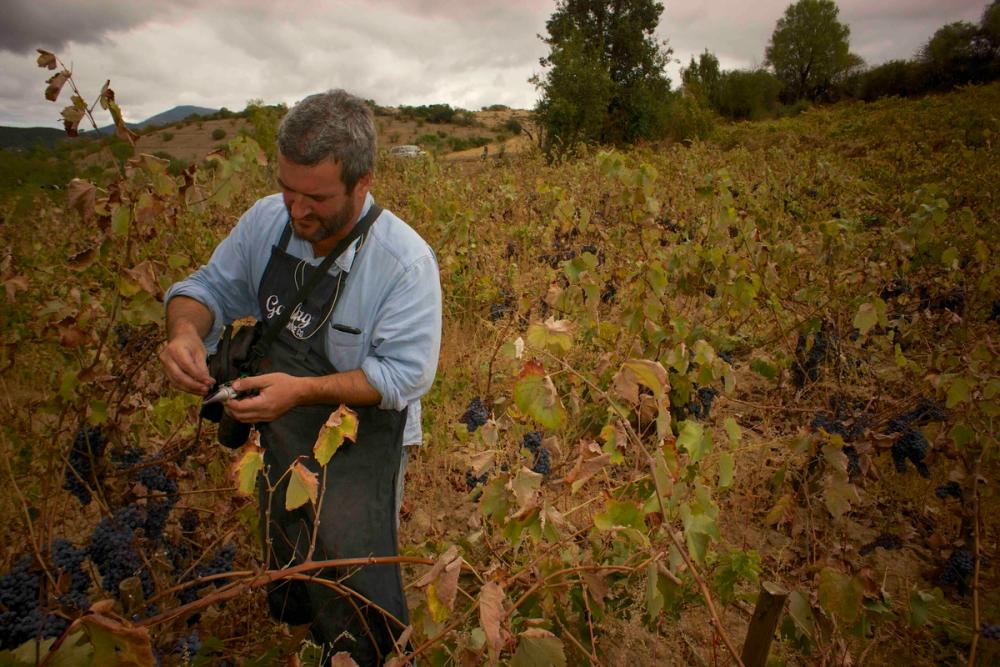
Derek Mossman Knapp working in his Maule vineyard. Picture Matt Wilson. Www.MattWilson.cl
Any new wines in the range you would like us to know about
Yes and no.
Yes: after more than a dozen vintages working in Truquilemu we have made our first Cru – a cut above the parcels. Fermenting pieces of the vineyard separately over many years two distinct personalities emerged. We have bottled them separately since 2018. Cru is not the cream off the top of our well-known Truquilemu V, nor does it have more oak, but rather it is a second of two wines with distinct personalities from the same vineyard. Each is treated differently to accentuate its distinct personality. We think our existing Truquilemu V. (Lot 97 current release)has become more ethereal for the separation. And Cru is born a more sturdy wine with extra stuffing and tension. She benefits from a kind of buttressing effect that more liberal inclusion of stems produces.
And no: after 20 years making wine, we are releasing our Lot 100 + series: Old Vine Pale Rosé Lot 103(Some still do not realise this means our 103rd bottling since we began in 2001)
How do you see the overall quality of wines from Chile and are you seeing the steps you have been making over the years
I think the big have benefited from the pressure that has been placed on small and independent wine businesses in recent years. Today the larger wineries offer a greater diversity of wines than they once did and have more small interesting lots. The small have had an important role in encouraging innovation that Chile has taken a decade or more to understand, but I think now they get it. ‘Big’ was always more beautiful in the eyes of Chileans. Chile often speaks of getting past the b’s: bueno, bonito y barrato, but the ‘b’ they are hung up on is ‘big’.
For me Alt-Chile is the category to watch. Propeller in UK has a new platform to get various MoVI (Movement of Independent Vintners) wines into the UK. There are many more wineries today that are focused on being and staying small and making quality from old vines and new terroirs like Viñedos de Alcohuaz up in Elqui. Marcelo Retamal: Reta as we have called him for years, has left De Martino and is now independent. It will be interesting to see what comes from Reta going forward first from Alcohuaz and then who knows.
Which parts of the world really understand and engage with your story and what you are doing?
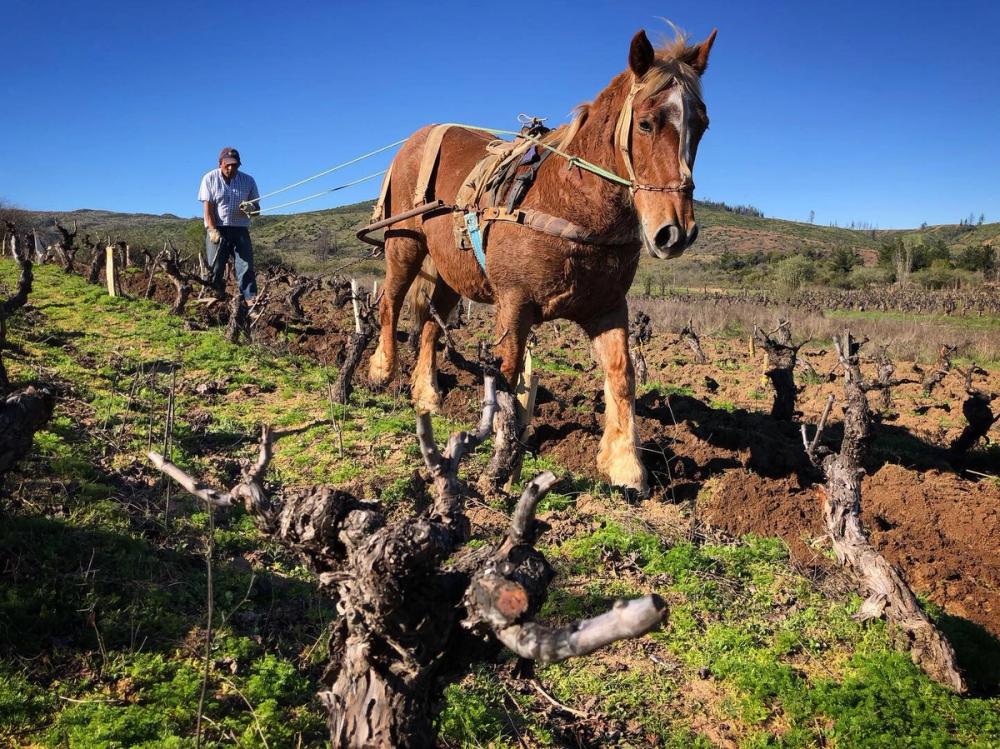
The traditional, hands on, vineyard and people first story of Garage Wine Company is one that resonates around the world
Garage exports to 16 countries. We trade a good deal in the US, UK, Sweden and Germany, but our portfolio has a long tail. We are growing in places like Thailand, Poland, Panama & Bermuda as these markets mature. More lately we are trying to do more in Asia and slowly making inroads in South Korea, China and Japan.
Anything else we can expect in the coming months?
A visit from Jascot’s with a bottle of Garage under one arm and a Coravin in the other.
When do you think you will be able to travel again = what impact has not travelling had on the business?
I look forward to getting out to taste with buyers. I think there is a tremendous learning on both sides through this age-old tradition in the trade, but I am also aware of the opportunities that zoom has created. Before, my contact with say, the Atherton Group, was 10 minutes on a very busy day with a buyer. Thanks to zoom, a few months back, I had a 90 minute session with every server across five or six restaurants. I hope we can keep these zooms going and I hope the diving-up of bottles into small ampules will continue too.
